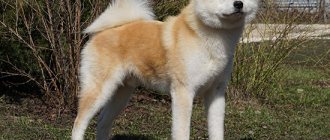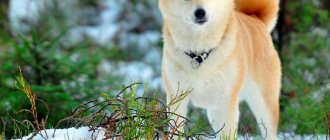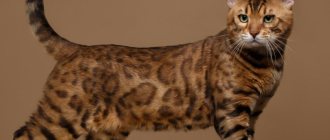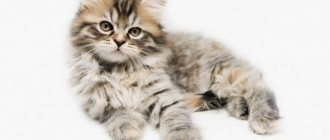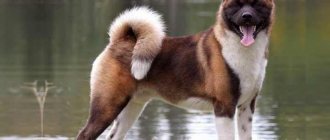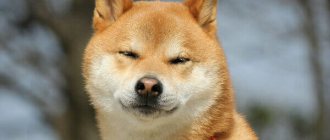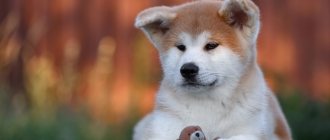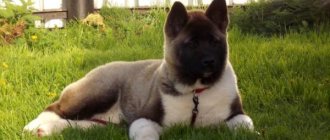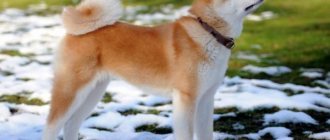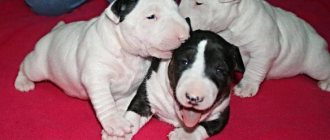How it develops day by day in the first month
Experts divide the development of Akita puppies into stages:
- From birth to 10 days, primary adaptation to external conditions occurs, including unfamiliar smells and temperature changes. After 48 hours, babies' coats begin to become shiny and they look plump. During the first 7 days, the doggies double their weight. Weak and strong individuals are determined by activity.
- Up to 20 days - after opening their eyes, babies try to walk unsteadily and perceive extraneous sounds better. The formation of baby teeth is activated, the puppies make their first attempts to leave the nest and relieve themselves outside the bed.
- Until the 30th day - dependence on the mother decreases, puppies are introduced to complementary foods in the form of liquid food. 2 to 3 additional feedings are allowed per day.
Important! After 1 month of life, the young animals begin to be transferred to standard nutrition.
Akita Inu puppies
Care and maintenance
Like any dog, the Akita Inu requires good care, quality nutrition, timely visits to the veterinarian, preventive vaccinations and training. No matter how strong an animal is by nature, it is necessary to monitor and maintain its health. No matter how golden the character of the Akita, it must be trained, as well as given the opportunity for active recreation and solitude.
- Wool . The Akita's amazing soft coat does not require frequent bathing. It has self-cleaning properties, so bathing is necessary 2 times a year. The wool does not have an unpleasant odor and sheds in autumn and spring. To prevent it from scattering around the house, it is necessary to comb it daily during the molting period. In normal times, brush your hair once a week.
- Vaccinations . Periodically vaccinate against dangerous diseases so that your dog does not get sick. Your veterinarian will advise you on a suitable vaccination schedule.
- Walks . Akita is not suitable for passive and elderly people, because they need to be walked frequently. The duration of the walk should not be less than 1.5 hours. She is a great companion for jogging and cycling. You can learn the “fetch” command and throw a stick at it, or play a ball, throwing it as far as possible. By running around during a walk, the Akita will release its energy.
- Own place . An equally important need for a dog is the opportunity to be alone with itself. Give your Akita a separate place that will belong only to her.
- Claws . Akitas do not need to trim their nails. If they don’t have time to grind on their own, it means you don’t walk your dog enough.
- Teeth . Once every 10 days you need to examine and brush your pet’s teeth. To do this, purchase special paste and brush at the pet store.
- Ears . Once a week it is necessary to clean the open ears of the Akita from dirt. To do this, it is enough to have cotton swabs. Dogs kept in an apartment are less likely to need this procedure.
Akita Inu is a strong and healthy animal, but it can also get sick:
- joint dysplasia is a genetic disease that threatens to completely immobilize the animal;
- eye diseases: entropy, glaucoma, cataracts;
- If you feed your pet incorrectly, he is at risk of gastric volvulus.
How it develops from 1 to 12 months
Monthly changes in the body of babies are shown in the table:
| Deadlines | Weight and size | Characteristics |
| 30 days | 3.5-4.5 kg 5.3-5.8 cm | After opening its eyes, the pet begins to move around and eat on its own. The amount of food is selected by the veterinarian; young animals should not starve or overeat. |
| 60 days | 8-10 kg 10-11 cm | After weaning from the female, the babies are taught to eat within 20 minutes. Afterwards, the food is removed, regardless of the presence of food residues. Animals' ears go up. |
| 90 days | 12-14 kg 15-17 cm | Includes education and training. This is the time of character development. |
| 4 months | 18-22 kg 21-23 cm | The ears take a characteristic stance. |
| 5 months | 22-25 kg 26-29 cm | The program includes walks to help the pet develop properly. Active games are played before meals, otherwise health problems may arise. |
| 6 months | 26-28 kg 31-34 cm | Visually, the young are similar to the adults. The characteristic puppy roundness disappears, the body acquires proportionality. |
| 7, 8, 9 months | 37-52 cm 30-37 kg | Character formation is completed. If no one has been involved in raising the animal, then it will be difficult to correct it. |
| 10-11 months | 37-40 kg 60-64 cm | Growth and weight gain slows down, the shape of the head and other parts of the body changes. Changes take place within 2 months. |
| 1 year | Females have their first estrus, but are not ready to continue breeding. |
Important! Akita Inus are allowed to breed from the age of two; they cannot give birth earlier or accept offers from owners of male dogs.
The standard cycle of a female dog lasts 25 days.
Weight table by month
The table below will help Akita owners track the development of their pets. The values given here are averages. Deviations from them up or down within 10% are allowed.
| Age (months): | Weight, kg): | Height (cm): |
| 1 | 3,5-5 | 30-35 |
| 2 | 8-10 | 35-38 |
| 3 | 12-14 | 38-43 |
| 4 | 18-22 | 43-50 |
| 5 | 22-25 | 50-56 |
| 6 | 26-28 | 55-60 |
| 7 | 30-32 | 57-60 |
| 8 | 30-34 | 60-62 |
| 9 | 30-37 | 60-54 |
| 10 | 30-38 | 60-66 |
| 11 | 30-39 | 60-58 |
| 12 | 30-40 | 60-70 |
As for the parameters of adult animals, these are medium-sized dogs:
- Boys. Height at the withers is 65-70 cm, weight is 30-40 kg.
- Girls. Height at the withers is 60-65 cm, weight is 20-30 kg.
In adult Akita Inu, gender differences are clearly visible:
- Girls may be slightly longer than boys.
- Boys have a wider muzzle, head, and skull than girls.
Today, the height at the withers of the Akita Inu is not a decisive factor at shows. First of all, experts pay attention to the dog’s bone structure, color, head proportions, character, coat quality, and the severity of the dog’s sexual characteristics.
How to care
Care is directly related to age characteristics; it is necessary to take into account the standards of education and nutrition. Its unpretentiousness and thick coat make it possible to keep animals in enclosures or ordinary apartments.
The coat does not require special care; it is enough to brush your pet weekly. This approach helps prevent the formation of tangles. During seasonal shedding, dogs are brushed daily.
Important! Removing dead hair helps the coat renew itself faster.
Combing when shedding
American Akita - puppy nutrition in the first three months
Nutritional features of an Akita puppy up to 3 months:
- Up to 30 days - up to three weeks, babies feed on mother's milk, then supplementary feeding is introduced into the diet. Food is given in liquid form; with natural feeding, low-fat and light soups are used. Veterinarians do not recommend getting carried away with self-prepared food; it is better to feed them with specialized ready-made diets.
- The second month passes under the sign of weaning from mother's milk and ends with the transition to liquid and dry food. Biscuits are given in minute quantities, after 20 minutes the food is removed from the bowls - it should not remain in them all day.
- Third month – consumption of meat and dairy products increases. You should not buy cheap economy-class feed, so as not to cause problems with the gastrointestinal tract in young animals. Preference is given to premium, super-premium, and holistic diets.
Important! With a natural diet, by the end of the third month of life, it is better to give puppies meat. By-products are not suitable for this.
Dry food for Akita
Akita Inu puppies: choosing a friend
Cute, clumsy babies, similar to little bear cubs, are usually taken away by their future owners 2 months after birth. At a later age, Akita Inu puppies become strongly attached to the place where they were born. Therefore, they get bored for a long time, find it difficult to settle into a new home, and have difficulty getting used to the owner.
A purebred dog can only be purchased from a specialized nursery. The breeder must provide the buyer with information about pedigree, vaccinations, and complete all documents necessary for a successful exhibition career.
Breed standards:
- the head is large, with a wide forehead and a black nose;
- almond-shaped eyes – dark, slightly slanted, deep-set;
- ears – triangular with rounded tips;
- the body is moderately elongated, with strong, muscular legs;
- the tail is quite long, curling into a ring on the back.
The soft and thick fur of the Akita can have different colors. The characteristic color is white, red or brindle with a white mask on the muzzle.
Important! The future owner should know that a pet's childhood extends to 2 years. Kids of this breed mature much later and remain playful and playful kids for a long time. Only over time do Akita Inu puppies become more restrained, display protective qualities and independence of character.
A healthy puppy is playful, active, and curious. He has a good appetite, shiny fur, and clear eyes. You should not take a timid, weakened, inactive puppy. Most likely, he will lag behind in growth and development and require increased attention in care and feeding.
How to feed correctly and how often
Feeding takes place twice a day, portions are gradually increased. After six months, the daily amount of food varies from 0.5 to 0.7 kg.
Pets are predisposed to rapid weight gain, so the daily menu should be balanced and agreed upon with a veterinarian. With a natural diet, meat is regularly replaced with fish, and instead of whole milk, the baby is given cottage cheese or fermented milk products.
Important! When the dog turns 9 months old, the amount of dairy products in the diet is reduced to three meals per week, the rest of the diet includes vegetables and cereals with meat. Veterinarians recommend giving preference to ready-made industrial feeds - when using them, animals do not need additional multivitamin supplements.
Feeding
Representatives of this breed can be fed with natural products or industrial dry food. Each type of feeding has pros and cons, so there is no clear answer which one is better. The choice depends on the views and preferences of the dog owner, the main thing is not to mix them.
The number of daily feedings depends on the age of the pet:
- 2 months – 5 times;
- 4-5 months – 4 times;
- 6-8 months – 3 times;
- 9 months and older – 2 times.
With a natural diet, the dog’s diet should include:
- dietary meat (beef, rabbit, turkey) raw or scalded with boiling water;
- cereals (rice, buckwheat);
- boiled sea fish;
- low-fat fermented milk products (yogurt, kefir, cottage cheese);
- eggs (no more than once a week);
- offal (lung, liver, tripe, heart);
- seasonal fruits and vegetables (carrots, zucchini, apples);
- sea kale.
It is prohibited to give your pet:
- fat meat;
- spicy food;
- sweets, pickles, seasonings, smoked foods, marinades;
- garlic, onion;
- bakery and pasta products;
- tubular bones;
- river fish;
- legumes
When eating natural foods, vitamin-mineral complexes (Unitabs Brevers Complex, Beaphar Doggys, Radostin) are additionally included in the diet.
Approximate weekly diet for an adult:
| Day of the week | Menu |
| Monday | 600 g turkey, 400 g rice porridge, 400 ml kefir, 500 g vegetables |
| Tuesday | 800 g beef, 400 ml yogurt, 400 g vegetables, 400 g rice porridge |
| Wednesday | 1 kg of sea fish, 300 g of buckwheat porridge, 400 g of cottage cheese, 500 g of vegetables, 2 tsp. seaweed |
| Thursday | 600-800 g beef, 300-400 g rice porridge, 400 g cottage cheese, 400 g vegetables, 2 tsp. seaweed |
| Friday | 1 kg of sea fish, 300 g of buckwheat porridge, 500 g of cottage cheese, 300 g of vegetables, 2 tsp. seaweed |
| Saturday | 1 kg of sea fish, 300 g of buckwheat porridge, 500 g of cottage cheese, 1 egg, 400 g of vegetables |
| Sunday | 800 g rabbit meat, 400 g buckwheat porridge, 500 g cottage cheese, 400 g vegetables, 2 tsp. seaweed |
If the choice falls on industrial feed, you should not purchase economy class products. These foods do not contain the vitamins and minerals necessary for a dog’s growth and development; they contain a lot of grains and meat waste. Premium or super-premium food is suitable for American Akitas. Products from the brands Hills, Royal Canin, Monge, and Bosch are popular among breeders.
How to train and what commands to teach
A trusting relationship with a pet is built through caring and affection. Correct completion of tasks is rewarded with praise and treats. Before the general training course, the pet must memorize:
- given name;
- rules of behavior on the street - walk nearby, respond to the first call;
- a basic set of commands: “sit”, “lie down”, “voice”, “paw”, etc.
Important! The breed is distinguished by high intelligence and stubbornness. You cannot achieve anything from animals through cruelty; this approach ends badly for the owner and the animal.
How to toilet train
Babies are initially taught to relieve their natural needs using a special diaper. It is impossible to immediately teach them to go to the toilet - babies will not be able to go for walks twice a day.
Important! The ability to tolerate and defecate outside the home is developed in young animals after six months. Slowly developing individuals cope with the task closer to the first year of life.
First walks
Description of Akita Inu puppies by month. Basics of feeding and education, prices for dogs
The Akita Inu breed appeared in 1600 in the Japanese province of Akita, from where the dogs got their name. They were intended to protect royalty. They were also used for hunting large animals, such as bears.
In the 20th century, representatives of this breed came to America. Akita Inu became popular after the story, and later the film adaptation, Hachiko. Then the breed became famous throughout the world.
Many families wanted Akita Inu as their pet. They can be described as loving, reserved, loyal and fearless.
How to choose
The popularity of the breed allows you to choose a pet to your liking. Initially, the future owner must determine for what purpose the puppy is being purchased, then the search for a reliable breeder begins. Beginners should:
- believe the pedigrees of both parents;
- obtain information about tests and vaccinations performed;
- find out how the birth of this American Akita went.
Important! It is better to buy young animals from a veterinarian, who will quickly identify sick individuals.
Choosing a pet
History of the origin of the American Akita Inu and characteristics of the breed
The American Akita (akita american) is a young dog breed that is rapidly gaining popularity around the world. Their colorful appearance and strength, which is noticeable to the naked eye in these dogs, make them desirable pets for many dog breeders. However, it should be understood that a harmonious appearance does not guarantee a soft and flexible character.
Features for different types of breed
The nuances of varieties of purebred animals include “elite” Japanese, which are rarely found in Russia. This subspecies has the habit of openly ignoring commands and performing only what is interesting to itself. When raising any Akita, you cannot use physical force: the pet will remember the offender and will take revenge for the rest of its life.
Japanese and American Akitas are cute dogs with unique personalities. Raising children should begin at an early age; training gaps in older individuals are difficult to fill. Proper nutrition and care will allow you to grow a smart and quick-witted dog from a baby.
History of the breed
In 1932, all of Japan was shocked by a story published in one of the Tokyo newspapers. It told about Hachiko, the faithful Akita Inu dog, who came to the train station every day to meet his owner. One day the owner never returned. It turned out that the man died, but the faithful dog continued to come year after year to the place where he met his owner. The publication of the article had a great resonance, and a monument was erected to the devoted Hachiko. The dog was present at its opening. Years later, he still continued to come to the railway station, where he died 9 years after his owner. During the Second World War, the monument was damaged, but people restored it and now it has become a popular meeting place for lovers, a symbol of fidelity, constancy, and devoted love.
Written sources indicate ancient Japanese dogs were used to hunt large animals. It is believed that this animal appeared long before the advent of writing, which means that the history of this breed goes back several thousand years.
The homeland of the dog is considered to be the Japanese island of Honshu, whose inhabitants for a long time lived separately from other islanders, because getting there was difficult even in the summer. Years later, local tribes were driven out of the island and came to the territory of modern China. They took their faithful Akita Inu hunting dogs with them. This is how the world learned about the existence of these amazing animals.
At some point, the breed was on the verge of extinction. However, the Japanese authorities took emergency measures and declared the Akita Inu a national treasure of Japan.
Dog breeders used large dogs for several purposes. This is how three varieties of these dogs emerged.
- Hunting . It is considered the most ancient. It was used when hunting large wild animals, and most often bears. Another name for this breed is “Japanese wolf”.
- Watchdog . As time passed, people's needs changed, and the Akita Inu began to be used to protect people's homes and possessions.
- Boytsovskaya . Such dogs were very popular in battles, because they were distinguished by their power and strength, which forced even a much larger enemy to retreat. However, in 1908, dog fighting became illegal and breeding of this subspecies stopped.
Some breeders are experimenting with the size and appearance of these animals. This is how a larger animal was bred in America, which was later separated into a separate breed and called the Japanese dog.
